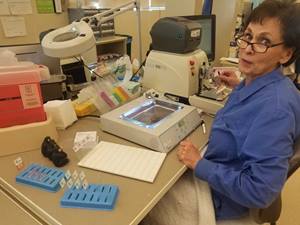
Intermountain is celebrating this year’s National Medical Laboratory Professionals Week by thanking our more than 1,500 lab professionals who over the last four years reduced lab expenses by $26.5 million — $23.5 million of which was in 2018. The Central Lab also returned $4.3 million to their partner facilities last year because they exceeded their budget targets.

- They worked with the Supply Chain Organization to renegotiate contracts with suppliers at lower rates. Because the lab was united as One Intermountain, they were able to use their expanded buying power to negotiate better deals with Intermountain’s main reference lab — the vendor where we send tests that can’t be completed internally — as well as with the American Red Cross and with the lab’s main supplier of instruments and reagents. “We had a total savings of close to $5 million last year just from supplier renegotiations,” says Karen Brownell, executive director of Laboratory Services.
- They brought some lab tests in-house that had previously been sent out to outside labs.
- They moved some testing to the Central Lab that had previously been done at various hospital labs around the system. Karen says this not only reduced costs because of the increased resources available at the Central Lab, but also in many cases it helped providers get results faster. “For example, the lab team in Dixie now sets up the cultures and then places them into special incubators in the courier vans, and the Central Lab team will perform the tests once the courier arrives in Murray,” Karen says. “The results are getting done six to eight hours sooner than before. When you’re able to consolidate more things in one place there are economies of scale to be gained.”
- They made staffing more efficient to better meet patient needs. To minimize staff overlap and provide broader coverage to patients, the lab went from a rotating seven days on/seven days off schedule to regular eight-hour shifts (except the graveyard shift) across all facilities. “This was a tremendous effort that impacted our caregivers’ schedules both inside and outside of work,” Karen says. “We appreciate their support and appreciate the increased efficiency that helps us keep our costs down.”
- They’ve standardized many processes and workflows. “We’ve identified many things that varied from one lab to the next across the system and have worked to create standardized best practices that help improve efficiency,” says Karen. “We’ve only touched the tip of the iceberg on these standardization efforts.”
- They’ve established a systemwide client service team. This team is committed to reporting all critical values — patient lab results that indicate a life-threatening condition — to the ordering provider within 30 minutes of when the lab receives results. “In the past the Central Region was the only area that had this dedicated team, and in other parts of the system lab workers would have to interrupt their regular work to contact providers,” Karen says. “Now, thanks to the increased teamwork that’s part of our One Intermountain efforts, we’ve been able to expand the client service resource across the system.”

A lab caregiver
Karen says if the client service team can’t locate the ordering provider or if the provider can’t locate the patient within 30 minutes, a pathologist in the patient’s area will help deliver the results. In some cases, critical results have quickly reached patients thanks to heroic efforts. For example, a young man from out of state was with his family in Park City last summer when he came into an InstaCare because he wasn’t feeling well. When his lab results came back as life-threatening, the team couldn’t get ahold of the ordering provider, so instead the results were released to Sterling Bennett, MD, the lab’s medical director, who tracked down the father’s cell phone in iCentra and called. Dr. Bennett let him know his son needed to go to the Park City ED as soon as possible. The son was diagnosed with type 1 diabetes.
“The lab team makes a positive impact on our patient’s lives on a daily basis, but it’s easy to forget about us because we operate largely behind the scenes,” says Karen Brownell, executive director of Laboratory Services. “Please take a moment this week to tell them thanks for their dedication and expertise.”
In addition to cost savings, here are three ways the lab is adding new growth:
- In early January 2018, a lab services provider that worked with several skilled nursing facilities in Utah announced it would be leaving the state within a month. Lab teams from Central Laboratory, Utah Valley, and Dixie Regional all rallied to offer their services. They quickly expanded a mobile phlebotomy to serve 11 new skilled nursing facilities, most of which were brought online within six weeks. “It was a heroic effort by a lot of people to pull everything together so quickly,” Karen says. The lab is now exploring opportunities to expand skilled nursing facility support further.
- As the largest hospital laboratory in the state, the Central Lab already contracts to provide lab services for multiple outside groups, and Karen says they have capacity to increase the volume of contracted work substantially. “We’re already one of the top 50 outreach labs in the country,” she says. “With minimal investment we could bring in more revenue, so we’re actively pursuing those opportunities. More volume helps drive down costs in other parts of the system."
- The lab is hoping to launch a telehealth pathology program in the future that’ll allow pathologists to view lab results and make diagnoses remotely. This program would serve both Intermountain facilities and contracted rural facilities.
The lab is also helping to identify at-risk patients before they get sick. For example, they recently partnered with SelectHealth to offer colon cancer screenings for all SelectHealth’s Medicare Advantage enrollees. Dr. Bennett was the ordering physician for all the screenings, saw all the screening results, and if a test came back positive for possible colon cancer, he contacted the patient personally and connected the patient with a primary care physician for follow up. The team also coordinated with the Surgical Specialties Clinical Program to help patients get colonoscopies.
One result: The percentage of enrollees who were screened jumped from 80 percent in 2017 to 85 percent in 2018.
“Colon cancer is treatable if it’s caught early enough,” says Karen. “This was a great way to catch the cancer sooner. At least one patient was found to have early colon cancer as a result of our efforts. It was so successful that we plan to do it again in 2019 with an expanded group. We’re excited to move more into the ‘predict and prevent’ business.”
Nannette Berensen, vice president of clinical systems says, "Our laboratory caregivers and pathologists have worked together to produce amazing results. Their efforts have contributed in a meaningful way to making care more affordable."
Intermountain’s lab team includes phlebotomists, clinical laboratory assistants, histology and pathology techs, transcriptionists, medical laboratory scientists, PhDs, pathologists, and many more laboratory support teams.
Karen says the lab team provides great value for patients, with lab results providing 70 to 75 percent of diagnostic results, but only 3 to 5 percent of the total cost of care to patients. “The lab team makes a positive impact on our patient’s lives on a daily basis, but it’s easy to forget about us because we operate largely behind the scenes,” says Karen. “Please take a moment this week to tell them thanks for their dedication and expertise.”

